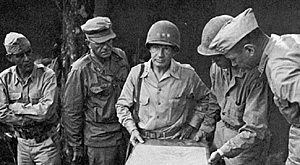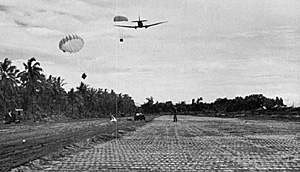The 3d Marine Division had borne the brunt of operations thus far, but it was not to be allowed to settle down in comfort behind its defenses. Admiral Halsey had other plans. The Americal and 40th Divisions had at first been scheduled for the projected assault against Kavieng, but Halsey now wanted the I Marine Amphibious Corps, consisting of the 3d Marine Division and the 40th Infantry Division, to conduct the operation.
He proposed sending General Griswold's XIV Corps headquarters to Bougainville to relieve General Geiger's headquarters, and transferring the Americal Division from the Fijis to relieve the 3d Marine Division. (The 40th was then in Hawaii due for shipment to the South Pacific.)
When Halsey first announced his plan on 2 November General Harmon opposed it, but Halsey overrode his objections.
Thus on 15 December General Griswold relieved General Geiger of command of all Allied air, surface, and ground forces based at Empress Augusta Bay and in the Treasuries. Admiral Halsey also made Harmon his informal deputy for supervising operations of the XIV Corps. On Christmas Day came the first troops of the Americal Division, the 164th Regimental Combat Team. Bidden farewell by one of the area's frequent earthquakes, the battle-weary 3d Marines departed on the ships that had carried the 164th.
On 28 December General Hodge arrived and took over command of the eastern sector from Turnage, and the 182d Regimental Combat Team prepared to take over from the 2ist Marines. The 132d Regimental Combat Team took over its part of the line on 9 February, and five days later the Americal's field artillery battalions, the 221st, 245th, 246th, and 247th, began relieving the 3d Division's artillery regiment, the 12th Marines. (Total casualties for the I Marine Amphibious Corps to 15 December were:
- 1. Empress Augusta Bay, 293 killed, 1,071
wounded, 95 missing, and 1,161 sick and evacuated.
(The relatively large figure for missing was due to the
McKean's sinking and the loss of many of her
passengers.)
2. Treasuries, 53 killed, 174 wounded, and 1 missing.
3. Choiseul, 7 killed, 14 wounded, 4 missing. In addition I Marine Amphibious Corps lost several men at the base depot in Vella Lavella to aerial bombardment. Of the total casualties, the 3d Marine Division lost the most--186 killed, 624 wounded. The 37th Division suffered 10 wounded during the period. All these figures are taken from a casualty report in I Marine Amphibious Corps' report, Phase III. The 3d Marine Division reported that it had counted 2,100 dead Japanese.)
The 3d Defense Battalion and several Marine air squadrons remained at Empress Augusta Bay.
With the Japanese quiescent in December except for intermittent air attacks at night, the immediate problems facing Griswold were logistical rather than tactical. The road net had to be finished; a good road net would not only improve the supply situation but would give Griswold all the benefits of interior lines if and when the Japanese attacked in strength. The inland airfields had to be completed, beach congestion ended, more dumps and depots established. General Griswold stated the problem thus:
Puruata Island was so heavily loaded down it was about to sink. All beaches were congested. No long range supply road system had been planned. Long hand carry was the rule, particularly in the Marine Division sector (later the Americal) for the front line troops. Forward ration dumps, ammunition and bomb dumps, gasoline dumps, hospital areas and bomb shelters for the same, beach developments, interior supply roads, the Service Command area itself, a central cemetery, refrigeration, sawmills, drainage ditches, and a myriad of other
 LT. GEN. MILLARD F. HARMON, center, and Maj. Gen. Oscar W. Griswold, second
from left, are briefed by a Marine officer.
things were non-existent, and not even
visualized. Space for all these things had to be
carved out of the virgin jungle. (Ltr, Griswold to
Barnett, CofS USAFISPA, 15 Feb 44, quoted in
SOPACBACOM, The Bougainville Campaign, Ch. 5,
P. 239, OCMH.)
LT. GEN. MILLARD F. HARMON, center, and Maj. Gen. Oscar W. Griswold, second
from left, are briefed by a Marine officer.
things were non-existent, and not even
visualized. Space for all these things had to be
carved out of the virgin jungle. (Ltr, Griswold to
Barnett, CofS USAFISPA, 15 Feb 44, quoted in
SOPACBACOM, The Bougainville Campaign, Ch. 5,
P. 239, OCMH.)
Griswold, characterized by Halsey as "a farsighted and capable planner," set to work with his staff. (Halsey, Narrative Account of the South Pacific Campaign, p. 11, OCMH.)
Harmon's headquarters contributed greatly to the solution of the logistical problems by activating, in New Caledonia on 15 December, a Provisional Service Command, for Bougainville. This organization, specifically tailored for the particular mission of supporting the XIV Corps, began its operations on Bougainville on 6 January 1944. By 31 January its strength was slightly more than two thousand men.
Logistical development under Griswold was extensive and orderly. By now the swamp had been drained. Malaria was kept rigidly under control. The volcanic ash of the region made adequate roads, but the heavy rainstorms that fell almost daily tended to wash them away. Road maintenance was therefore one of the most difficult logistic problems.
By 1 March forty-three, miles of two-way and thirty-six miles of one-way roads had been built. The troops also cleared several acres for gardens. The hot sun and frequent rains gave them fair returns, and fresh vegetables, normally a rarity in that part of the world, improved the otherwise almost unvarying diet of C and K rations and dehydrated foods.
Green vegetables grew fairly well, but tomatoes and corn did not. (Ltr, Hon. Hugh M. Milton, II (former CofS, XIV Corps), to author, 13 Jul 56, OCMH. Exceptions to the unvarying diet were: turkey for Thanksgiving and Christmas, steak early in 1944, and fresh (cold storage) eggs on Easter Sunday.)
There were frequent distributions of books, movies, performances by motion picture and radio personalities, sports, and occasionally beer and soft drinks. Empress Augusta Bay was about as pleasant a beachhead as one could hope for.
During the first two and a half months following Griswold's assumption of command there was no heavy fighting. There were not enough troops to hold all the high ground inland, but combat and reconnaissance patrols went out to the east, the north, and the west to keep tab on all the possible routes of Japanese approach. Airplanes also reconnoitered trails, and PT boats, water routes.
One of the outstanding patrols was conducted by the 1st Battalion of the Fiji Infantry Regiment, which arrived in late December. This battalion, composed Of 34 officers (some white, some Fijian) and 777 enlisted Fijians, was at first commanded by Lt. Col. J. B. K. Taylor of New Zealand. But Taylor was wounded his first night ashore and was replaced by Maj. Geoffrey T. Upton, also of New Zealand. (The Fijians added more color to the beachhead than did any other unit. Immaculate in appearance, they were nearly all men of extraordinary physical stature. They obviously liked soldiering and their marching was impressive in its precision. They sang well and often, their repertoire ranging from their native songs through "Onward Christian Soldiers" to "Pistol Packin' Mama" in Fijian.)
A detachment of the Fiji battalion left the beachhead on 28 December and walked through the mountains over the Numa Numa Trail to the village of Ibu, east of the mountains, where they set up an outpost on 3o December. From Ibu these natural jungle fighters kept watch over enemy movements on the east coast so that no Japanese could advance unsuspected along the Numa Numa Trail. They reported to corps headquarters by radio and were supplied by air drops from C-47's. They also hacked an airstrip suitable for L-4 planes (Piper Cubs) on the 1,700-foot-high shelf that Ibu rests on.
But during December 1943 all ground operations were of minor importance when compared with the air operations against Rabaul that were conducted by South Pacific aircraft.
December Attacks Against Rabaul
Eight Seabee battalions and one New Zealand engineer brigade had begun work on a fighter strip at Cape Torokina promptly after D Day. Because the area was one of the few relatively dry patches of ground at Empress Augusta Bay, there was some competition among other units to occupy it, but the squatters were evicted and the builders were able to work unimpeded.
(This section is based on Craven and Cate, The Pacific: Guadalcanal to Saipan, PP. 350-52; Morison, Breaking the Bismarcks Barrier, PP. 392-98; USSBS, The Allied Campaign Against Rabaul, passim. See also Sherrod, History of Marine Corps Aviation in World War II, pp. 193-97)
 C-47 AIR-DROPPING SUPPLIES on a partially completed airstrip.
C-47 AIR-DROPPING SUPPLIES on a partially completed airstrip.
The strip was ready for operations on 9 December, and the next day seventeen F4U's of Marine Fighting Squadron 216 (1 Marine Aircraft Wing) flew in and set up at their new base.
Starting in mid-November B-24's of the Thirteenth Air Force had begun bombing Rabaul every few days, but now, with its new forward fighter fields at Torokina and in the Treasuries, Air Command, Solomons, was ready to start an intensive series of operations with the purpose of completely neutralizing Rabaul.
The Solomons air command now had a new commander. Maj. Gen. Ralph J. Mitchell of the Marine Corps relieved General Twining on 2o November. Twining returned to the United States, then went to Italy where he commanded the Fifteenth Air Force. ( In the closing days of the war, Twining led the Twentieth Air Force.)
The strength of General Mitchell's command was formidable, even after the intensive operations of October and November. He had, in operating condition on 17 December, 199 fighters, 200 light and medium bombers, and 99 heavy bombers, or about twice what the Japanese had in the entire Southeast Area. (Total strength of Mitchell's command, including non-operational planes, was 268 fighters, 252 light and medium bombers, and 111 heavy bombers.)
The first time the Torokina field was used against Rabaul was 17 December, when fighters from New Georgia staged through it on a 76-plane sweep. From then on it was almost continuously in use. For the rest of December, except when the weather was too bad for flying, Mitchell continued the attacks, varying fighter sweeps with fighter-escorted raids by B-24s. (On Christmas Day Halsey sent a carrier raid against Kavieng. He ordered a surface bombardment of Buka in order to lure out enemy aircraft, whereupon Admiral Sherman's two carriers (Bunker Hill and Monterey) struck Kavieng soon after sunrise. But Sherman's pilots found few targets.)
But Mitchell's, heavy bomber pilots, like Kenney's, were unable to knock out Rabaul, and toward the end of the year the Japanese sent in more planes. Medium, dive, and torpedo bombers would have to be used, and their employment would have to await completion of the strips near the Piva River. The first of these, termed Piva U or Piva Uncle, was started on 29 November and completed on 30 December. The second, Piva Yoke, was ready on 9 January 1944. (These dates are taken from Building the Navy's Bases in World War II, pp. 270-72.)
It was clear that the reduction of Rabaul would not occur until 1944. Kenney's and Mitchell's attacks in 1943, however, were quite effective, if not completely successful. They caused enough damage to make the Japanese garrison start wholesale excavation in November in an effort to put everything possible under ground and so escape complete destruction.
Meanwhile, under partial cover of the invasion of Bougainville and Mitchell's attacks on Rabaul, General MacArthur's forces had crossed Vitiaz and Dampier Straits to invade New Britain.
More Exploiting the Beachhead
Back to Table of Contents -- Operation Cartwheel
Back to World War Two: US Army List of Issues
Back to MagWeb Magazine List
© Copyright 2002 by Coalition Web, Inc.
This article appears in MagWeb (Magazine Web) on the Internet World Wide Web.
Other military history articles and gaming articles are available at http://www.magweb.com